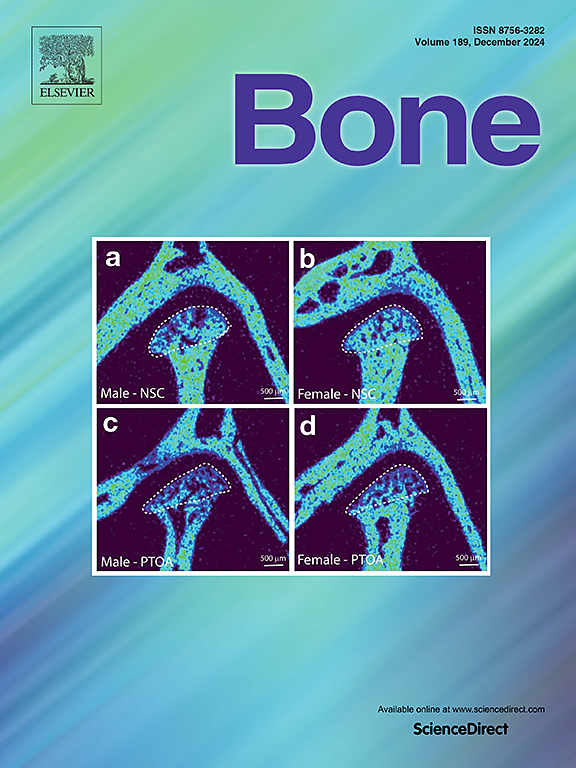Combined Romosozumab and Raloxifene treatment targets impaired bone quality in a male murine model of diabetic kidney disease
IF 3.5
2区 医学
Q2 ENDOCRINOLOGY & METABOLISM
引用次数: 0
Abstract
Comorbid diabetes and chronic kidney disease create a complex disease state with multi-faceted impacts on bone health, primarily reduced bone mass and tissue quality. To reduce fracture risk in this growing population, interventions are needed that target both bone mass and quality. Romosozumab (Romo) is an FDA-approved sclerostin inhibitor that has been shown to increase bone mass and strength in a murine model of combined diabetes and CKD (DKD), while Raloxifene (RAL) is a mild anti-resorptive used to treat osteoporosis that has also been shown to increase bone mechanical properties by increasing bone bound water content. We aimed to test whether combined RAL and Romo treatment could improve bone quality in our murine model of DKD more than either treatment alone. Using a previously established streptozotocin- and adenine-diet-induced model, male, C57BL/6J mice were randomly divided into four treatment groups and given daily subcutaneous injections of 100 μL vehicle (phosphorus buffered saline, PBS) or 0.5 mg/kg RAL. In addition, two groups were also given a weekly dose of Romo (10 mg/kg). Overall, Romo increased whole-bone strength and RAL improved tissue-level mechanical properties. Combined RAL-Romo treatment led to significantly higher cortical and trabecular bone mass compared to untreated controls. These morphological improvements created corresponding improvements in cortical bending strength and vertebral trabecular compression strength. These results suggest that combined RAL-Romo treatment provides both mass and quality improvements to DKD bone.
Romosozumab联合雷洛昔芬治疗糖尿病肾病雄性小鼠模型的骨质量受损。
合并症糖尿病和慢性肾脏疾病形成一种复杂的疾病状态,对骨骼健康有多方面的影响,主要是骨量和组织质量的降低。在这一不断增长的人群中,为了降低骨折风险,需要针对骨量和骨质量进行干预。Romosozumab (Romo)是一种fda批准的硬化蛋白抑制剂,已被证明可以增加糖尿病和CKD (DKD)联合小鼠模型的骨量和强度,而雷洛昔芬(Raloxifene)是一种轻度抗骨质吸收剂,用于治疗骨质疏松症,也被证明可以通过增加骨结合水含量来增加骨力学性能。我们的目的是测试RAL和Romo联合治疗是否比单独治疗更能改善DKD小鼠模型的骨质量。采用先前建立的链脲佐菌素和腺嘌呤饮食诱导模型,将雄性C57BL/6J小鼠随机分为4个治疗组,每天皮下注射100 μL载体(磷缓冲盐水,PBS)或0.5 mg/kg RAL。此外,两组还给予每周剂量的Romo(10 mg/kg)。总的来说,Romo增加了全骨强度,而RAL改善了组织水平的力学性能。与未治疗的对照组相比,RAL-Romo联合治疗可显著提高皮质和骨小梁骨量。这些形态学的改善产生了相应的皮质弯曲强度和椎小梁压缩强度的改善。这些结果表明,RAL-Romo联合治疗可以改善DKD骨的质量和质量。
本文章由计算机程序翻译,如有差异,请以英文原文为准。
求助全文
约1分钟内获得全文
求助全文
来源期刊

Bone
医学-内分泌学与代谢
CiteScore
8.90
自引率
4.90%
发文量
264
审稿时长
30 days
期刊介绍:
BONE is an interdisciplinary forum for the rapid publication of original articles and reviews on basic, translational, and clinical aspects of bone and mineral metabolism. The Journal also encourages submissions related to interactions of bone with other organ systems, including cartilage, endocrine, muscle, fat, neural, vascular, gastrointestinal, hematopoietic, and immune systems. Particular attention is placed on the application of experimental studies to clinical practice.
 求助内容:
求助内容: 应助结果提醒方式:
应助结果提醒方式:


